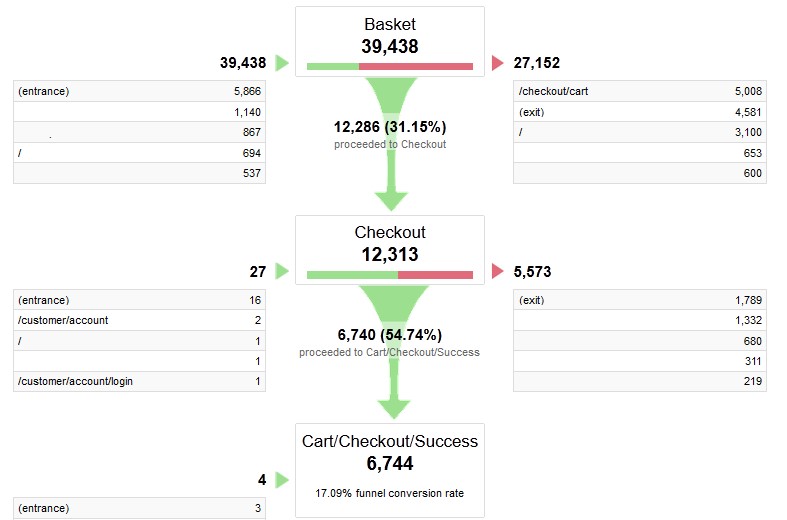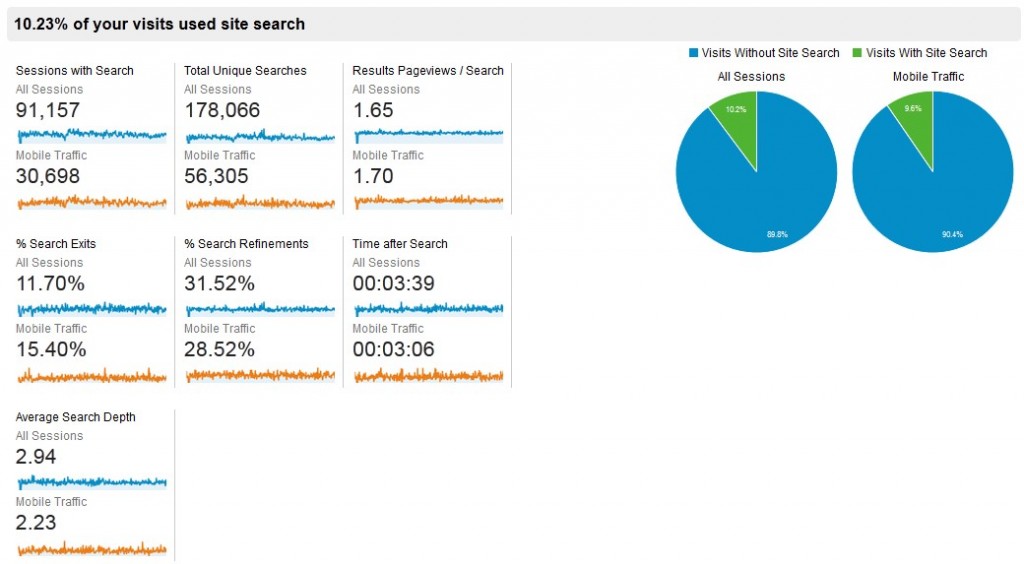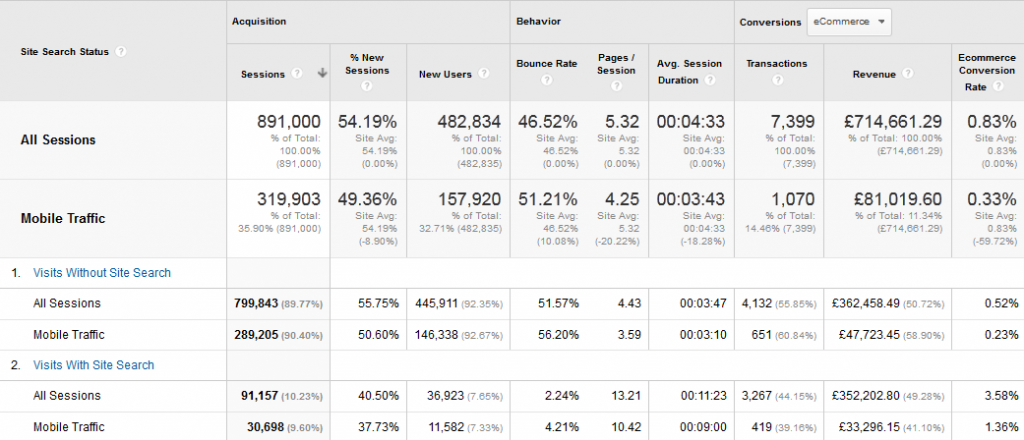My job has always mostly involved trying to drive more and more high-quality traffic to client’s websites. But the problem is, once that traffic gets there there’s a limit to how much influence I have over it. The bottom line is the end goal for business is always more revenue and a better return on investment. With SEO you can’t guarantee that. You can certainly improve the volume of traffic coming to the website but you can’t make those visitors spend their money, that’s down to them.

Anyone that knows anything about business and the way websites works already knows this. You’ll also know that what influences people to buy can depend on a million different things – seasonality, buying trends, supply and demand, price, delivery costs, user-friendliness of the site, customer service, reputation, customer loyalty, sales and discounts – just to name a few. But there are also elements of your website and its design which can have a direct influence on how visitors convert into customers.
Simple changes may improve your conversion rate in drastic ways. An obvious example of this is mobile. If you have an old clunky website that’s slow to load and difficult to navigate, chances are it’s an even worse experience on mobile. If people are out and about trying to shop on their phone while sitting on the train then they don’t want to have to pinch and zoom and fiddle with your site to find what they want. They may well find themselves getting frustrated and going elsewhere. Here a responsive design, big thumb and finger friendly buttons and a fast page load speed could make a world of difference.
Sometimes it’s the really little things. For example, some people have found that adding a secure checkout logo to their site has lead to as much as a 42% increase in sales. While others found the same change lead to a decrease in their conversion rate. Conversion rate optimisation is all about testing your website, making changes and testing again, and again and again.

Discovering Hidden Value
Before you can start to work on increasing your conversion rate you need to analyse how people are using your website and where the issues lie. There are many different ways you can do this – heat-maps, click-maps, session recordings, user-feedback surveys, user-testing etc. but there are also simply ways you can do it.
Funnel Problems
If you have goals properly set up on your website then finding problems in your funnel is a great way to find areas that need fixing to improve your revenue. Common issues will centre around things like dropping out at the basket or checkout stage. You can find this data in Google Analytics in the Goal Flow and Funnel Visualisation sections.

We’re looking for any area where red lines indicate drop out or where other lines of flow indicate there may be some confusion on how to use the site and people may be getting stuck in the funnel and not completing purchase.

I’ve redacted some of the information in the above screenshot for confidentiality’s sake but it still highlights issues with this website that need addressing. There are three simple steps in this checkout process. People add something to a basket, then move from basket to checkout and then the checkout succeeds (or fails). We can see there’s a significant drop out in the basket. Only 31.15% of people adding something to their basket are making it through to the next stage, then 54.74% from there to successful completion of the checkout.
Something is drastically wrong. As I’ve already said it could be a multitude of reasons – it could be the price was too much once they got to the basket and shipping was added, it could be (and their customers have actually said this) that people are adding items to the basket to get an idea of total price and may come back later to purchase or go into the store and buy instead, it could be because the site is hard to use on mobile or because a competitor was cheaper. We will never know all the answers, but we can test ways to improve the basket to reduce the drop out and a small change may make a big difference. You can imagine if we managed to increase the number of people staying through to checkout, even by as little as 5%, we’d make a significant difference to the revenue generation over the year.
It’s something that will need to be tested and re-tested with updates, tweaks and changes made to find the problem areas.
Site Search

Site search is a valuable area of potential data for your marketing. If you set-up Google Analytics properly, all you need to do is add the query parameter into the admin settings and you can see what people are searching for. This can be useful if you’re looking to optimise your site for SEO or capitalise on the way people are searching by working out ‘popular’ products, but it may have other uses too.
Site search may well be a hidden gem of your website which you can cash in on. In the above screenshot you can see for this site only 10.23% of visitors used the site search functionality. Not a great deal I’m sure you’ll agree. However, this data becomes far more interesting when you see the following:

Look closely at this data and you’ll see that despite only 10.23% of visitors using site search, visits with search accounted for around 50% of total revenue generated by the site for both mobile and desktop.
You can analyse this data in two ways – firstly, people visiting the website and using search may well be of a different mindset. They know what they’re looking for, they’re confident and they’re determined. They’re not new visitors who are just fumbling around the website and trying to find what to buy. This is demonstrated by the fact that visits with search also has a considerably lower bounce rate (around 2% compared to 50% without search) and a lot more pages viewed per visit. However, you could also argue that these people are struggling to find what they want from the standard navigation and perhaps even from the search itself.
In the first of these screenshots, you’ll see % search exits which shows how many users left the site after completing a search. So the data here shows that 11.70% of all users and 15.40% of mobile users left the site after making a search; which in turn shows those searchers were unhappy with the results for whatever reason.
Of course, their reasons for exiting could again be extremely varied – perhaps the site’s search functionality doesn’t work particularly well and returns unusual or unhelpful results, perhaps the stock levels are low or just not broad enough and the visitor couldn’t find what they were looking for (e.g. they were looking for a specific brand) or perhaps it’s something as simple as prices being too high compared to competitors so they decided to go and buy elsewhere.
With some clever analysis we could try to work out why they were leaving, but even before that we could try to find problems ourselves – if there’s something obviously wrong with the site’s search results then fixing it could result in a big win in terms of extra conversions and revenue. As I’ve already shown these visitors are extremely valuable, so it’s worth taking the effort to improve their experience and get more out of them.
Asking The Right Questions
There’s only so much information the analysis of data will give you. We can make educated guesses and try new things with plenty of testing, but one of the best ways to find hidden value in your site is to ask the people using it.
Your customers are your most valuable source of information, but not just your customers, those visitors who arrive but get frustrated for whatever reason and leave again – those are the gold mine. If we can get those people to tell us what’s wrong then we’re more likely to be able to keep them happy and keep future people like them on the site. This works well because people are always happy to complain when they’ve found issue with a website.

Common complaints may highlight issues with the website that you weren’t aware of. If there’s a consistency to the sort of feedback you’re getting then you can be sure that the problem isn’t just a one off. Here are some examples of the sort of feedback we’ve seen (in my words for the sake of confidentiality):
- The pricing isn’t clear enough. Am I paying monthly or is it one off?
- Delivery costs are extortionate. I could get it much cheaper on eBay.
- I can’t find what I’m looking for.
- I get frustrated with adding things to the basket. I add something and it takes me to the basket, but if I want multiple items from the same page I have to go back to that page and repeat over and over again!
- Technical problems stopped me from making a purchase.
You can see there’s various different hints here as to problems with the site that could be addressed. Some of them are related to more general business matters – i.e. charging too much for delivery but others are related to the design of the website, the functionality (not being able to find things) or something as simple as frustration with adding things to the basket.
Let’s take that last one as an example as it would take time to cover them all. Imagine the website if you will, it’s an e-commerce website with a wealth of products. You can add items to your basket from category pages but product pages also have multiple products on them as well (the main product and related paraphernalia). However whenever you click ‘buy’ to add a product to your basket you get taken to the basket page and if you wanted multiple items you have to click back in your browser or ‘continue shopping’ in the basket page. The result of this is user frustration no doubt.
Now imagine your visitor is using a mobile device to browse and buy on your website. They’re on a train and their signal is sporadic at best. They’re trying to add items to their basket but then they have to go back and their browser doesn’t load because of the data problems, so they have to reload the site. Eventually they manage to get 2 products in, but there’s plenty more they want to add and they keep having to go back and forth. Eventually they’ve finished but they realise it’s time to get off the train so they don’t finish their order – hopefully they’ll remember to do it later but it’ll probably time-out and delete their basket by then. Maybe they’ll end up with a competitor whose website is far less frustrating!

This sort of knowledge is invaluable as with a few simple changes to the website we can easily improve user experience and this sort of problem is something that might otherwise have gone unnoticed.
These are just some of the hidden gems of your website that we can find and improve on – the end result being more revenue and a better user-experience for your customers. Find out how to get even more value out of your website with our CRO guide.

